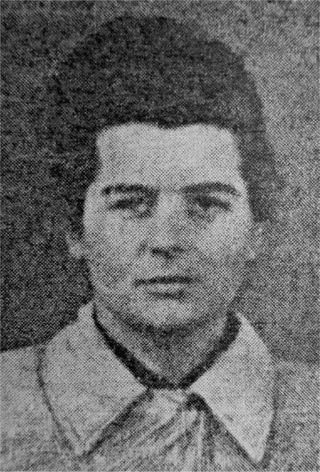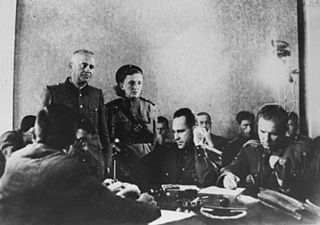
Irma Ilse Ida Grese was a Nazi concentration camp guard at Ravensbrück and Auschwitz, and served as warden of the women's section of Bergen-Belsen. She was a volunteer member of the SS.

Majdanek was a Nazi concentration and extermination camp built and operated by the SS on the outskirts of the city of Lublin during the German occupation of Poland in World War II. It had seven gas chambers, two wooden gallows, and some 227 structures in all, placing it among the largest of Nazi concentration camps. Although initially intended for forced labor rather than extermination, it was used to murder people on an industrial scale during Operation Reinhard, the German plan to murder all Polish Jews within their own occupied homeland. In operation from 1 October 1941 to 22 July 1944, it was captured nearly intact. The rapid advance of the Soviet Red Army during Operation Bagration prevented the SS from destroying most of its infrastructure, and Deputy Camp Commandant Anton Thernes failed to remove the most incriminating evidence of war crimes.

Neuengamme was a network of Nazi concentration camps in northern Germany that consisted of the main camp, Neuengamme, and more than 85 satellite camps. Established in 1938 near the village of Neuengamme in the Bergedorf district of Hamburg, the Neuengamme camp became the largest concentration camp in Northwest Germany. Over 100,000 prisoners came through Neuengamme and its subcamps, 24 of which were for women. The verified death toll is 42,900: 14,000 in the main camp, 12,800 in the subcamps, and 16,100 in the death marches and bombings during the final weeks of World War II. Following Germany's defeat in 1945, the British Army used the site as an internment camp for SS and other Nazi officials. In 1948, the British transferred the land to the Free Hanseatic City of Hamburg, which summarily demolished the camp's wooden barracks and built in its stead a prison cell block, converting the former concentration camp site into two state prisons operated by the Hamburg authorities from 1950 to 2004. Following protests by various groups of survivors and allies, the site now serves as a memorial. It is situated 15 km southeast of the centre of Hamburg.

Hildegard Martha Lächert was a female guard, or Aufseherin, at several concentration camps controlled by Nazi Germany. She became publicly known for her service at Ravensbrück, Majdanek and Auschwitz-Birkenau.

Therese Brandl was a Nazi concentration camp guard.

Aufseherin was the position title for a female guard in Nazi concentration camps. Of the 50,000 guards who served in the concentration camps, training records indicate that approximately 3,500 were women. In 1942, the first female guards arrived at Auschwitz and Majdanek from Ravensbrück. The year after, the Nazis began conscripting women because of a shortage of male guards. In the context of these camps, the German position title of Aufseherin translates to (female) "overseer" or "attendant". Later female guards were dispersed to Bolzano (1944–1945), Kaiserwald-Riga (1943–44), Mauthausen, Stutthof (1942–1945), Vaivara (1943–1944), Vught (1943–1944), and at Nazi concentration camps, subcamps, work camps, detention camps and other posts.

Maria Mandl was an Austrian SS-Helferin and a war criminal notorious for her role in the Holocaust as a top-ranking official at the Auschwitz II-Birkenau and Ravensbrück concentration camps. She was executed for committing crimes against humanity.
Margot Elisabeth Dreschel, also spelled Drechsel, Drechsler or Drexler, was an SS-Aufseherin at Nazi concentration camps during World War II. For her role in the Holocaust, she was sentenced to death and hanged.

The Belsen trials were a series of several trials that the Allied occupation forces conducted against former officials and functionaries of Nazi Germany after the end of World War II. British Army and civilian personnel ran the trials and staffed the prosecution and judges.

Richard Baer was a German SS officer who, among other assignments, was the final commandant of Auschwitz I concentration camp from May 1944 to January 1945, and right after, from February to April 1945, commandant of Mittelbau-Dora concentration camp. Following the war, Baer lived under an assumed name to avoid prosecution but was recognized and arrested in December 1960. He died in detention before he could stand trial.

Johanna Bormann ; 10 September 1893 – 13 December 1945) was a German prison guard at several Nazi concentration camps from 1938. She was executed as a war criminal at Hamelin after a court trial in 1945.

Alice Orlowski was a German concentration camp guard at several of the Nazi concentration camps in German-occupied Poland (1939-1945) during World War II. After the war, a Polish court convicted of her crimes against humanity, and she served 10 years in prison in Poland. In 1973, Orlowski, now 70 and living as a pensioner in West Germany, muttered that only "half the work" had been finished, referring to the Holocaust. She was promptly arrested, convicted of making antisemitic remarks, and sentenced to 10 months in prison.

Arthur Liebehenschel was a German commandant at the Auschwitz and Majdanek concentration camps during the Holocaust. After the war, he was convicted of war crimes by the Polish government and executed in 1948.

Luise Danz was a Nazi concentration camp guard in World War II. Danz was captured in 1945 and put on trial for crimes against humanity at the Auschwitz trial in Kraków, Poland. She was sentenced to life imprisonment in 1947, but released due to general amnesty on 20 August 1957.
Franz Hermann Johann Maria Freiherr von Bodmann, sometimes written as Bodman was a German SS-Obersturmführer who served as a camp physician in several Nazi concentration camps.

Anton Thumann was a member of the SS of Nazi Germany who served in various Nazi concentration camps during World War II. After the war, Thumann was arrested by British occupation forces and charged with war crimes. At the Neuengamme Camp Case No. 1 in 1946 he was found guilty, sentenced to death and executed at Hamelin Prison.

Else Lieschen Frida "Elsa" Ehrich was a convicted war criminal who served as a Schutzstaffel (SS) guard in Nazi concentration camps, including at Kraków-Płaszów and the Majdanek concentration camp during World War II. She was tried in Lublin, Poland at the Majdanek Trials and sentenced to death for war crimes. Ehrich was hanged on 26 October 1948.

Anneliese Kohlmann was a German SS camp guard within the Nazi concentration camp system during World War II, notably, at the Neuengamme concentration camp established by the SS in Hamburg, Germany; and at Bergen-Belsen. She was tried for war crimes at the Belsen Trial in Lüneburg in 1946.

The Majdanek trials were a series of consecutive war-crime trials held in Poland and in Germany during and after World War II, constituting the overall longest Nazi war crimes trial in history spanning over 30 years. The first judicial trial of Majdanek extermination camp officials took place from November 27, 1944, to December 2, 1944, in Lublin, Poland. The last one, held at the District Court of Düsseldorf began on November 26, 1975, and concluded on June 30, 1981. It was West Germany's longest and most expensive trial, lasting 474 sessions.

SS-Gefolge was the designation for the group of female civilian employees of the Schutzstaffel in Nazi Germany. SS-Gefolge members served the Schutzstaffel in a limited capacity, as the organisation was not formally a part of the SS. Members of the Gefolge worked in the Nazi concentration camps as guards and nurses.

















